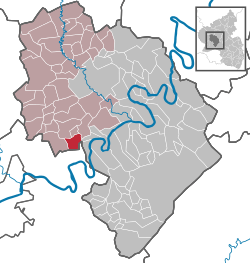Rivenich
Rivenich is an Ortsgemeinde – a municipality belonging to a Verbandsgemeinde, a kind of collective municipality – in the Bernkastel-Wittlich district in Rhineland-Palatinate, Germany.
Rivenich | |
|---|---|
 Coat of arms | |
Location of Rivenich within Bernkastel-Wittlich district  | |
 Rivenich  Rivenich | |
| Coordinates: 49°52′39″N 6°50′46″E | |
| Country | Germany |
| State | Rhineland-Palatinate |
| District | Bernkastel-Wittlich |
| Municipal assoc. | Wittlich-Land |
| Government | |
| • Mayor | Günter Thul |
| Area | |
| • Total | 7.78 km2 (3.00 sq mi) |
| Elevation | 140 m (460 ft) |
| Population (2018-12-31)[1] | |
| • Total | 714 |
| • Density | 92/km2 (240/sq mi) |
| Time zone | CET/CEST (UTC+1/+2) |
| Postal codes | 54518 |
| Dialling codes | 06508 |
| Vehicle registration | WIL |
| Website | www.rivenich.de |
Geography
Location
The municipality lies in the Eifel on the river Salm. The municipal area is 33% wooded. The nearest city is Trier, some 24 km away to the southwest. Rivenich belongs to the Verbandsgemeinde of Wittlich-Land, whose seat is in Wittlich, although that town is itself not in the Verbandsgemeinde.
History
In 748, Rivenich had its first documentary mention as Riveniacus. After the French Revolution, the village became part of the Department of Sarre. In 1814 it was assigned to the Kingdom of Prussia at the Congress of Vienna. Since 1947, it has been part of the then newly founded state of Rhineland-Palatinate.
Politics
Municipal council
The council is made up of 12 council members, who were elected by proportional representation at the municipal election held on 7 June 2009, and the honorary mayor as chairman.
The municipal election held on 7 June 2009 yielded the following results:[2]
| SPD | FWG | Total | |
| 2009 | 7 | 5 | 12 seats |
| 2004 | 5 | 7 | 12 seats |
Coat of arms
The German blazon reads: Schild schräglinks stufenförmig geteilt, vorne in Silber ein roter Drache, hinten in Rot drei goldene Ähren.
The municipality's arms might in English heraldic language be described thus: Per bend sinister indented, argent a dragon segreant gules and gules three ears of wheat conjoined on one stem slipped Or.
Written history records that on 30 December 1704, Count Hugo Ernst Cratz von Scharfenstein donated all his rights to the villages of Rivenich and Erlenbach to Baron Karl Kaspar von Kesselstatt, Provost of the Trier Monastery of St. Paulin. With the family von Kesselstatt's approval, the charge borne by the former barons (later Imperial counts) appears on the dexter (armsbearer's right, viewer's left) side. The step-shaped division of the field recalls the “fess dancetty” (horizontal zigzag stripe) formerly borne as an heraldic device by the Lords of Manderscheid, and thereby also Rivenich's time under the Manderscheid-Bruch high court. Likewise, the charge on the sinister (armsbearer's left, viewer's right) side recalls a composition once seen on a court seal (from 1765). These three ears of wheat stand for the parish's patron saint, Brice of Tours.[3]
Rivenich was granted the right to bear its own arms in 1975 by the Regierungsbezirk administration.
Economy and infrastructure
Northwest of Rivenich runs the Autobahn A 1. In nearby Hetzerath is a railway station on the Koblenz-Trier railway line.
Famous people
- Günter Rösch (b. 1943), politician
- Klaus Toppmöller (b. 1951), footballer, football trainer and municipal councillor (SPD)
- Dino Toppmöller (b. 1980), footballer, Klaus Toppmöller's son
References
- "Bevölkerungsstand 2018 - Gemeindeebene". Statistisches Landesamt Rheinland-Pfalz (in German). 2019.
- Kommunalwahl Rheinland-Pfalz 2009, Gemeinderat
- Description and explanation of Rivenich’s arms
| Wikimedia Commons has media related to Rivenich. |